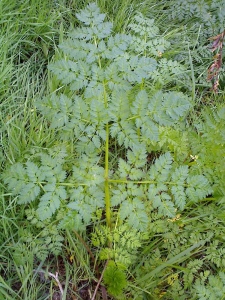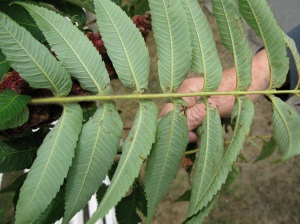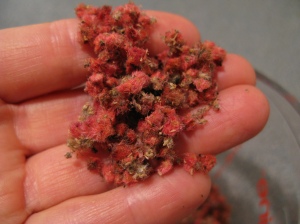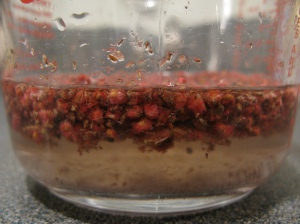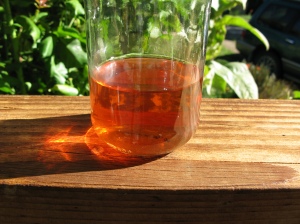You are currently browsing the category archive for the ‘poisonous plants’ category.
I picked this up from the US herbalists. Sumac is a small tree that’s often planted in NZ gardens for ornamental value. It has distinctive red flower/fruit heads that last on the tree well after all the leaves have dropped. The trunk and branches are elegant, lending to the sculptural look.
This sumac is also known as staghorn sumac, Rhus thyphina, which helps differentiate it from related poisonous species*. The best way to ID sumac is by the ‘berries’. It took me a while to be sure that I had the right plant because sumac berries aren’t very berry like. Instead they are a horn-shaped cluster of small, red, furry bits:
I still haven’t found out if those are flowers, fruit or seeds, but the Americans call them berries.
The leaves are quite distinctive too, being obviously symmetrical:
Additional ID keys are the furry stems, and when you break them they ooze a white substance.
*If you read US sources of information about this plant there are cautions about not confusing it with poisonous sumac (a related plant). I don’t think this is an issue in NZ because (a) the poisonous sumac is rare (not sure if it even exists in NZ), and (b) it doesn’t look like staghorn sumac – poison sumac has drooping white berry clusters, not upright red ones. The leaves also look different.
Sumac Lemonade
Once you are sure you have the right plant, pick a few heads. It’s best to not pick straight after a rain, as rain washes off some of the tasty bits.
Pull the seeds off and put into a container.
Cover with cold water (yes, cold. Hot water makes the brew too strong) and squash the seeds a bit into the water.
I left mine overnight which made a very strong brew too, which I watered down. Subsequent batches I’ve made with 1 seed head to 2 cups of cold water, steeped up to an hour. Play around and see what works for you. When ready, strain the brew well to remove the fine hairs and bits of seed.
The taste of sumac is refreshingly sour and astringent. You can add honey or sugar if you like, but I’ve been happy drinking it as is. Drink a small amount the first few times to see how your body reacts – sumac is also medicinal and can make you pee more. I didn’t notice anything obvious and have been enjoying a glassful at a time.
You can dry sumac heads for later use (infusion or spice).
Things I want to try:
~ a longer infusion for maximum vitamin C extraction
~ a sumac berry vinegar (‘cos I have to try most things in a vinegar)
~ sumac as a dry spice (sumac is a traditional middle Eastern spice. A local forager told me to mix ground sumac, thyme and salt).
~ sumac honey
~ sumac and berries or other seasonal fruit (there’s a local company making sumac and plum relish).
Sumac resources
Matt Wood discusses on video different species of sumac, its use as a spice, and as medicine.
Susun Weed video on Euell Gibbons’ washing machine method for large batches of sumac lemonade!
I like this plant. But it can be very poisonous, and looks like some other plants that aren’t poisonous and are edible so I thought I’d do an ID post.
Please read this post on IDing plants safely.
Hemlock, Conium maculatum, is a biennial of the Umbelliferae family. That family has a wide range of edible plants including carrot, fennel, and sweet cicely. Wild carrot and cicely in particular have leaves very similar to hemlock.
It can grow very tall (taller than me). Often you see the spent seed stalks amongst the new growth. It has feathery, fern-like leaves. There are two good ways to tell if it’s hemlock:
1. Hemlock has a distinctive smell, that to us smells ‘bad’ when crushed i.e. it’s stinky.
2. Hemlock has purple blotches on its stem (usually).
Because hemlock is so poisonous, it’s best to ID any similar looking plant two ways. Know how to recognise hemlock so you can exclude it, and know how to recognise each Umbelliferae you want to harvest i.e. don’t rely solely on looking at a plant and thinking it doesn’t have purple blotches on the stems therefore it must be edible. Go the next step and positively ID the plant you are looking at.
Young hemlock showing the stems with purple markings:
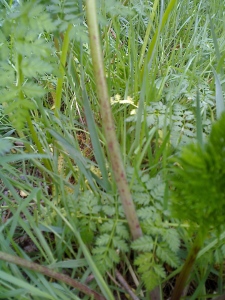
Hemlock leaf:
